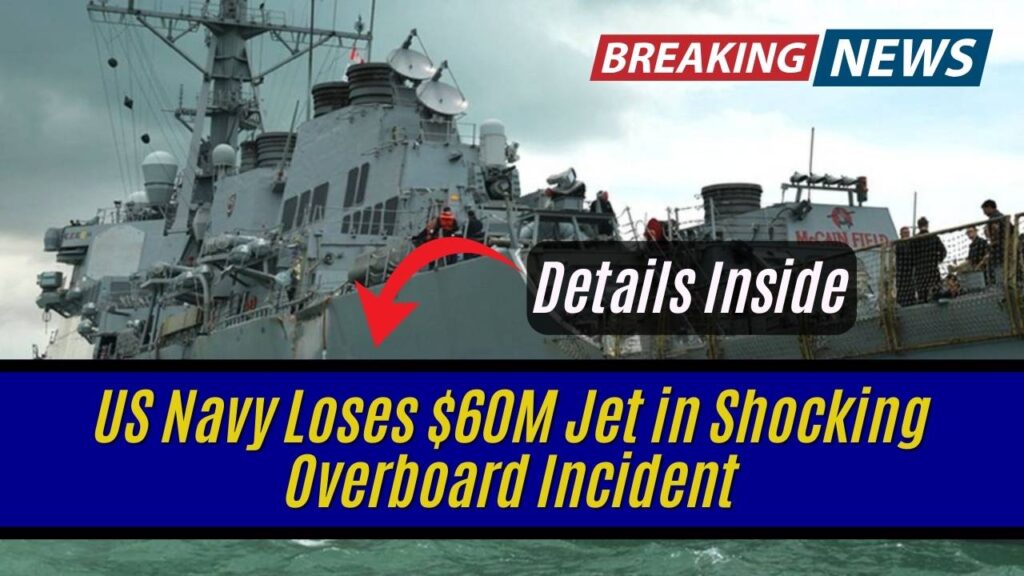US Navy Loses $60M Jet in Shocking Overboard Incident – The US Navy faced a major setback on April 28, 2025, when a $60 million F/A-18E Super Hornet fell overboard from the USS Harry S. Truman during operations in the Red Sea. The shocking incident unfolded during a high-tension mission aimed at countering Houthi rebel attacks. In a world where every fighter jet is a crucial national asset, such a loss not only demands scrutiny but also highlights the extraordinary operational risks our forces endure.

The aircraft, along with its tow tractor, plunged into the sea while being moved inside the carrier’s hangar. A sharp evasive maneuver to avoid incoming missiles from Houthi rebels may have contributed to the accident, although a formal investigation is underway. A Navy spokesperson said, “While unfortunate, this incident demonstrates the dynamic and hazardous environment our Sailors operate in daily. Safety reviews are already in motion to strengthen procedures.” Let’s break down what happened, why it matters, and what lessons can be drawn from this incident.
US Navy Loses $60M Jet in Shocking Overboard Incident
| Key Details | Information |
|---|---|
| Incident Date | April 28, 2025 |
| Location | Red Sea |
| Aircraft Lost | F/A-18E Super Hornet |
| Estimated Value | $60 million |
| Ship Involved | USS Harry S. Truman |
| Cause | Loss of control during towing + evasive maneuvering |
| Injuries | 1 sailor, minor injury |
| Ongoing Operation | Operation Rough Rider |
| Official Source | Business Insider, Politico, AP News |
The loss of the $60 million Super Hornet off the USS Harry S. Truman highlights the volatile realities of naval operations and the importance of improved safety, recovery capabilities, and strategic readiness. No lives were lost, and operations continue robustly. The upcoming investigation report could set new global naval standards.
What Exactly Happened?
The Super Hornet was being towed inside the hangar bay of the USS Harry S. Truman when disaster struck. Reports suggest the carrier had to make an abrupt evasive maneuver to dodge missile and drone attacks from Iran-backed Houthi rebels in Yemen. During this sudden shift, the towing crew lost control of the aircraft and tow tractor, causing both to roll overboard into the Red Sea. Fortunately, all crew members survived, with only one sailor sustaining minor injuries.
Why Was the USS Harry S. Truman in the Red Sea?
The USS Harry S. Truman has been deployed as part of Operation Rough Rider, a military initiative aimed at suppressing the capabilities of Houthi rebels threatening international shipping lanes. The Red Sea is one of the world’s most critical maritime corridors, connecting Europe to Asia through the Suez Canal. Disruptions here can have global economic impacts, making U.S. naval presence crucial. Since March 2025, U.S. forces, including assets from the Truman Carrier Strike Group, have conducted over 800 airstrikes to counter missile and drone threats.
A Pattern of Mishaps
Alarmingly, this is not the first aircraft loss involving the Truman Carrier Strike Group recently:
- December 2024: Friendly fire incident resulting in the downing of another F/A-18E.
- Early 2025: USS Harry S. Truman collided with a merchant vessel, causing the dismissal of its commanding officer.
Moreover, this incident echoes the 2022 loss of an F-35C Lightning II off the USS Carl Vinson, which also required an expensive deep-sea recovery operation.
Why Is Losing a Jet So Serious?
Beyond the staggering $60 million cost, the implications are far-reaching:
- National Security: Sensitive technology could be exposed.
- Global Readiness: Losing critical assets reduces operational capacity.
- Taxpayer Burden: Retrieval and replacement strain defense budgets.
Given that deep-water recovery involves highly specialized remotely operated vehicles (ROVs), costs can run into tens of millions of dollars.
Technical Challenges in Recovery
The Red Sea’s depth varies sharply, and retrieval depends on:
- Precise GPS tracking
- Seabed terrain
- Hostile Environment
Advanced technologies like deep-sea drones and AI-driven recovery subs may be deployed if the Navy decides to attempt recovery.
How Common Are Such Incidents?
Though rare, carrier deck mishaps are a well-acknowledged risk. Rough seas, hostile fire, and the complexities of shipboard operations all contribute. Historical precedent:
- USS Carl Vinson F-35C Crash (2022)
- USS Harry S. Truman Super Hornet loss (2022)
Both incidents involved successful but costly recovery missions.
What Happens Next?
The Navy has launched a full investigation that will:
- Determine the root cause.
- Recommend enhanced safety measures.
- Possibly implement AI and sensor-based tow monitoring systems.
- Assess the feasibility of recovery.
Formal statements and a post-incident report are expected by mid-May 2025.
Strategic and Global Implications
- U.S. Military Posture: Need for increased assets in key zones.
- Allied Operations: Partners may review their protocols.
- Global Supply Chain: Protecting trade through the Red Sea.
Practical Lessons for the Future
- Reinforced Tow Procedures
- Emergency Drill Upgrades
- Recovery Tech Investment
IRS SETC Tax Credit 2025: Are You Eligible for a Big Payout? Find Out Now!
Trump Administration Reverses Course: Student Visas Reinstated After Backlash!
Consumers Outraged: Fairlife Faces New Class Action Over Alleged ‘Humane’ Deception
FAQs About US Navy Loses $60M Jet in Shocking Overboard Incident
Q1: How much does an F/A-18E Super Hornet cost?
An F/A-18E Super Hornet costs about $60 million.
Q2: Will the Navy recover the lost aircraft?
Evaluation is ongoing. Recovery is complex and expensive.
Q3: Was anyone seriously injured?
No. Only one sailor suffered minor injuries.
Q4: Why was the Truman performing an evasive maneuver?
To dodge incoming missile and drone attacks from Houthi rebels.
Q5: How important is the Red Sea strategically?
Vital — it connects Europe to Asia and carries 12% of global trade.










